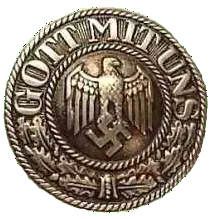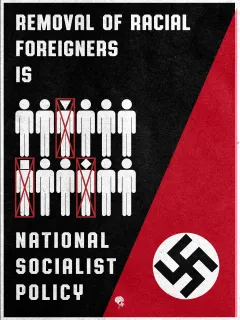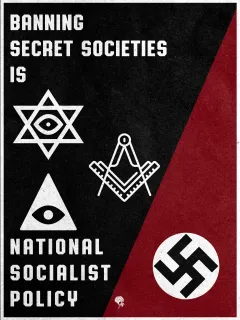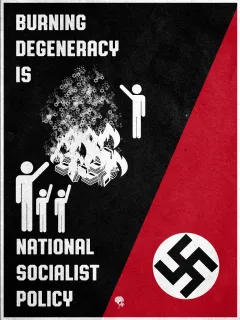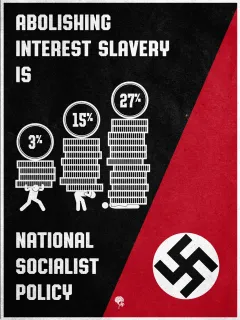The Enemy Within, Part 10: The Great Sedition Trials, Part 1
Previous Website Downloads
From the November-December 1999 issue of The Barnes Review.
TBR Magazine and Bookstore P.O. Box 15877 Washington, D.C. USA, 20003
Personal From The Editor [John Tiffany at the time]:
…Elizabeth Dilling (1894 – 1966) [was] one of the most forthright and determined American nationalist leaders of the 20th century.
A remarkably beautiful young lady with an early interest in music and languages, Elizabeth was an accomplished harpist and lived a comfortable life as the wife of a Chicago attorney and the mother of two children. She spent much time traveling abroad, and the more she did so, the more she came to love the United States. In particular, Elizabeth also came to loathe the communist system which she observed first-hand on a trip to the Soviet Union in 1931. She was appalled by what she saw, and upon her return home, she began an extensive study of the history of communism and the secret forces behind that alien, anti-American philosophy.
What started out as a part-time avocation, lecturing at churches and community groups on the subject of communism and its dangers, ultimately turned into a full-time duty for this determined American patriot. Within a few short years she was a nationally known figure and had written several widely read books. And as war in Europe loomed, Mrs. Dilling stood in the forefront of the America First movement, which said that Europe's conflicts were not our own and that America had no business fighting in a war that need not and should not be fought.
In fact, it was precisely because Elizabeth Dilling was so outspoken that she was among a group of Americans who were ultimately indicted by the Justice Department of President Franklin D. Roosevelt on charges of sedition.
Mrs. Dilling was dragged to Washington, D.C. and prosecuted as one of the defendants in what is now remembered as "the Great Sedition Trial" of 1944. She was accused-like the others-of interfering with the U.S. war effort even though her son, Kirkpatrick, was serving in the U'S, armed forces at that time.
This issue of TBR features an in-depth overview of the Great Sedition Trial. Although it is a remarkably complex and very important subject, there's actually been very little published on this bizarre case, but Michael Collins Piper has managed to assemble a highly readable history of this little-known trial. We've been surprised to note how few modern-day patriots (including even many TBR readers) had ever heard of this historic trial....
From the Editorial:
Franklin Roosevelt's Great Sedition Trial
The definition of sedition is very subjective. Our Webster's New Collegiate Dictionary defines it as "incitement of resistance to or insurrection against lawful authority," but who is to judge what is "lawful authority"? Certainly in today's context, Americans who identify sympathetically with the history of our country, and who love the lawful authority stemming from the Constitution, find themselves trying very hard to "incite resistance or insurrection" against the usurpers and aliens who have seized "lawful authority." Indeed, we find ourselves in lineal descent of the patriotic if luckless American heroes who were indicted by Franklin D. Roosevelt in 1942 in what has since become known as the Great Sedition Trial even though, sad to say, only a relatively few Americans have ever heard of this monumental miscarriage of American justice.
In truth, the defendants were trying to incite resistance to FDR's ruinous war policies, bless them, and if events since then have not more than justified their apprehension of what they then feared Roosevelt's policies would mean to the United States, then the observer must be deaf and blind to the precipitous decline of our country since 1945.
Treason is defined in the Constitution (Article III, Section 3), and as such is the only crime defined in that document. It reads: "Treason against the United States, shall consist only in levying War against them, or in adhering to their Enemies, giving them aid and comfort."
There is a very good reason why treason is defined in the Constitution, and it was fresh in the minds of the Framers when they wrote it. As students of history they were well aware that throughout the centuries of English regal tyranny, the kings had defined their political opponents as traitors deserving of the legal penalty for treason: death in whatever sadistic form their minds could conceive. As the result, many English heads dropped into baskets.
In succeeding years, American politicians, being unable to dispose of their opponents by branding their opposition as treasonous and hanging them, have resorted to charging them with sedition.
The Alien and Sedition Acts, created by the Federalist Party, generated the nation's first major crisis over civil liberties. Readers of TBR will recall how, in the summer of 1798, the Federalists, under President John Adams, were in political control of the United States. Still, there remained many politically active Republicans, which the Federalist Party considered a threat. To crush political dissent, the party's majority in Congress passed a group of bills known collectively as the Alien and Sedition Acts. Unfortunately for the Federalists, it was widely felt by the American people that these statutes flew in the face of the Bill of Rights. (Remember, by the way, it is to the Anti-Federalists that we owe the Bill of Rights.)
The Sedition Law made it illegal to criticize the U. S. government. What had happened to freedom of speech, or of the press, they wanted to know.
Here we had just fought a war for freedom, and within a few years it was being taken away from us. No wonder people were angered. The act was condemned by public opinion as susceptible for being used for the purposes of governmental oppression and terrorism.
The anger of the people was such as to turn the Federalist Party out of office and make it extinct, while boosting Thomas Jefferson into the presidency. But American history was not yet done with sedition.
Most educated Americans are aware that in October 1949, 11 members of the Communist Party USA were convicted of violating the Smith Act, popularly known as the 1940 Sedition Act. The constitutionality of that act (which prohibited advocacy of the violent overthrow of the central government or the organization of any group promulgating such a philosophy) was upheld in Dennis us. United States (1950) by the U.S. Supreme Court.
Less well known by far is the story of how the Smith Act was used in 1942 against some 43 Americans who opposed Roosevelt and his plans to drag America into the European war which was then raging, and which has become known as ''World War II" only because he was successful in his evil design. It is very significant that all of the indictees were relative small fry. None of them had any real power, prestige or authority
Roosevelt's plan in indicting them was to create a climate of fear among his opponents and to develop momentum so that he could dispose of the leaders of the America First Committee and the other outspoken isolationists in Congress and public life, such as Charles Lindbergh, Gen. Robert E. Wood, Father Coughlin, Huey Long, Col. Robert R. McCormick and a cadre of patriots in the Senate who fought with blood in their shoes against Roosevelt and the Jewish-British machine determined to intervene in a war which was none of our business.
To accomplish this object, FDR had to first establish the precedent that opposition to his war plans was sedition-the closest he could come to treason, thanks to the Constitution.
The result was a travesty of justice, although no one was actually convicted. The prosecution wound up looking like fools. In fact, this incident was so embarrassing to the government and the establishment that it has been covered up by the court historians and journalistic propagandists since then. The government managed to make itself look bad. Liberals fear embarrassment should the facts become well known. Conservatives ignore the trial, because they fear being labeled as anti-Semitic.
In this issue TBR brings you the story of the fateful but little-known Mass Sedition Trial. To give it the space it deserves, we've had to put a number of other articles, on other subjects, on hold until next issue. We feel that you will agree with us that Mike Piper has produced a great piece of work and we thank him for his exertions. Let's not forget the story of the sedition trial in Fort Smith, Arkansas in 1988.
Reminiscent of FDR's show trial, this also failed to stop public dissent to the policies of the Zionists and internationalists who seek to criminalize patriotism and once again the government wound up with egg on its face. Shortly we plan to bring you an account of that historic and – again - little known affair.
Please remember that although TBR is copyrighted, permission is given for anyone to make copies of our articles for free distribution so long as full credit is given to TBR, including our mailing address. Or, extra copies are available for sale so long as they may last.
A Mockery of Justice – The Great Sedition Trial of 1944
By Michael Collins Piper & Ken Hoop
According to historian Harry Elmer Barnes - this magazine's namesake - who was one of FDR's leading critics from the academic arena, the purpose of the Great Sedition Trial was to make the Roosevelt administration "seem opposed to fascism" when, in fact, the administration was pursuing totalitarian policies. Too few Americans today know of this travesty, a shameful blot on U.S. history.
"Judges and lawyers alike will tell you the mass sedition trial of World War II will go down in legal history as one of the blackest marks on the record of American jurisprudence. In the legal world, none can recall a case where so many Americans were brought to trial for political persecution and were so arrogantly denied the rights granted [guaranteed-Ed.] an American citizen under the Constitution." 1
This is how the Chicago Tribune, then a voice for America First in a media world already brimming with internationalism, described the infamous wartime "show trial" and its aftermath.
"The Great Sedition Trial" formally came to an unexpected halt on November 30, 1944, having been declared a mistrial upon the death of the presiding judge. Yet, the case continued to hang in limbo with Justice Department prosecutors angling for a retrial.
However, on November 22, 1946, Judge Bolitha Laws of the U.S. District Court for the District of Columbia, dismissed the charges against the defendants, saying that to allow the case to continue would be "a travesty on justice." 2
Although the Justice Department prosecutors appealed the dismissal, the U.S. Circuit Court of Appeals for the District of Columbia upheld Judge Laws' ruling and, as a consequence, the saga of the Great Sedition Trial at long last came to a close. This brought to an end five years of harassment that the defendants had suffered, including-for some-periods of imprisonment.
Judge Laws had thus called a halt to this Soviet-style attack on American liberty. Sanity had prevailed and the case was shelved forever. The war was over and the one individual who was the prime mover behind the trial-Franklin D. Roosevelt-was dead.
According to historian Ronald Radosh, a self-styled "progressive" who has written somewhat sympathetically of the pre-World War II critics of the Roosevelt administration, "FDR had prodded Attorney General Francis Biddle for months, asking him when he would indict the seditionists." 3 Biddle himself later pointed out that FDR "was not much interested ... in the constitutional right to criticize the government in wartime." 4
However, as we shall see, there were powerful forces at work behind the scenes prodding FDR. And they, more than FDR, played a major role in pushing the actual investigation Biddle was not enthusiastic to undertake.
Although there was a grand total of 42 people (and one newspaper) indicted - over the course of three separate indictments, beginning with the first indictment, which was handed down on July 21, 1942, the number of those who actually went on trial was 30, and several of them were severed from the trial as it proceeded.
Roosevelt's biographer, James McGregor Burns, waggishly called the trial "a grand rally of all the fanatic Roosevelt haters." 5 But there's much more to the story than that.
In fact, there were a handful of influential figures among the indictees. Among them included:
• Noted German-American poet, essayist and social critic, George Sylvester Viereck (a well-known foreign publicist for the German government as far back as World War I;
• Former American diplomat and economist Lawrence Dennis, an informal behind-the-scenes advisor to some of the more prominent congressional critics of the Roosevelt administration;
• Mrs. Elizabeth Dilling of Chicago, an outspoken and highly articulate author and lecturer who was well regarded and widely known nationally as a leader of the anti-communist movement and a fierce opponent of the administration;
• Rev. Gerald Winrod of Kansas. With a national following and wide-ranging connections among Christian ministers and lay leaders throughout the country, Winrod had emerged as a force to be reckoned with. In 1938 he ran a strong race for the U.S. Senate. (One of Winrod's proteges was none other than evangelist Billy Graham, who is said to have "learned much but kept quiet publicly about what he learned privately"6 as a young man traveling with Winrod.) And:
• William Griffin, a New York-based publisher with strong connections in the Roman Catholic Church. Many American Catholics were strongly anti-communist, and Irish-American Catholics, in particular, were generally skeptical of FDR's war policies at a time when, it will be remembered, the government of Ireland remained neutral in the war being waged against Germany by the United States and England, Ireland's traditional enemy.
However, most of those who finally went to trial were little known and hardly influential on a national level, other than the few exceptions just noted. Among the defendants were: a sign painter who was 80 percent deaf, a Detroit factory worker, a waiter and a maid.
In short, they were at best "average" Americans, without the means or the opportunity to be able to conduct the kind of seditious and internationally connected conspiracy that the government had charged, nor were they in any position to defend themselves against the unlimited resources of the central government. In many cases, the defendants were paupers, virtually penniless. Many of them were "one-man" publishers, reaching small audiences-hardly a threat to the mighty forces that controlled the New Deal. Several were very elderly. Few of the indictees even knew each other before the trial, despite the fact that the indictments charged them with being part of a grand conspiracy, orchestrated by Adolf Hitler, to undermine the morale of the American military during wartime.
Lawrence Dennis commented later that: "One of the most significant features of the trial was the utter insignificance of the defendants in relation to the great importance which the government sought to give to the trial by all sorts of publicity-seeking devices." 7
Unfortunately, in this brief study of the tangled circumstances surrounding the great sedition trial, we will be unable to provide all of the defendants the recognition they deserve. But by virtue of having been targeted for destruction by the Roosevelt administration and its behind-the-scenes allies for their patriotic anti-war stand, this handful of otherwise insignificant Americans became folk heroes.
Thanks to their more vocal compatriots, such as, perhaps most notably, Lawrence Dennis, we are able to commemorate the details of their plight today.
According to Dennis, it was the design of the sedition trial to target not the big-name critics of the Roosevelt war policies, but instead to use the publicity surrounding the trial to frighten the vast numbers of potential grass-roots critics of the intervention in the Eurasian war into silence, essentially showing them that, they, too, could end up in the dock if they were to dare to speak out as the defendants had in opposition to the administration's policies.
Wrote Dennis:
The crackpots, so-called, or the agitators, are never intimidated by sedition trials. The blood of the martyrs is the seed of the church.
The people who are intimidated by sedition trials are the people who have not enough courage or enough indiscretion ever to say or do anything that would get them involved in a sedition trial. And it is mainly for the purpose of intimidating these more prudent citizens that sedition trials are held ...
A government seeking to suppress certain dangerous ideas and tendencies and certain types of feared opposition will not, if its leaders are smart, indict men like Col. [Charles] Lindbergh or senators [Burton] Wheeler [D-Mont.], [Robert] Taft [R-Ohio] and Gerald Nye [R·N.D.], who did far more along the line of helping the Nazis by opposing Roosevelt's foreign policy as charged against the defendants than any of the defendants.
The chances of conviction would be nil, and the cry of persecution would resound throughout the land.
It is the weak, obscure and indiscreet who are singled out by an astute politician for a legalized witch-hunt. The political purpose ~ of intimidating the more cautious and respectable is best served in this country by picking for a trick indictment and a propaganda mass trial the most vulnerable rather than the most dangerous critics; the poorest rather than the richest; the least popular rather than the most popular; the least rather than the most important and influential.
This is the smart way to get at the more influential and the more dangerous. The latter see what is done to the less influential and less important, and they govern themselves accordingly. The chances of convicting the weaker are better than of convicting the stronger ... "8
One of the defendants-one of the weaker, less influential and less important, insignificant Americans targeted by FDR-was Elmer J. Garner of Wichita, Kansas. This elderly American patriot died three weeks after the trial began.
Sen. William Langer (R-N.D.), an angry critic of the trial, described the victim in a speech on the floor of the Senate. Garner, he said, was:
"A little old gentleman of 83, almost stone deaf, with three great-grandchildren. After he lost the mailing permit for his little weekly paper, he lived with his aged wife through small donations, keeping a goat and a few chickens and raising vegetables on his small home plot.
"Held in the [Washington, D.C.] jail for several weeks, for lack of bond fees, and finally impoverished by three indictments and forced trips and stays in Washington, he died alone in a Washington rooming house early in this trial, with 40 cents in his pocket. His body was shipped naked in a wooden box to his ailing, impoverished widow, his two suits and typewriter being held, so that clothing had to be purchased for his funeral. That is one of the dangerous men about whom we have been hearing so much." 9
According to attorney Henry Klein, an American Jew who defied the ADL by boldly serving as defense counsel for another of the defendants, Garner - who was a first cousin of FDR's first vice president (1933-1941), John Nance Garner - died at his typewriter in a tiny room in a Washington flophouse, typing out his defense. l0
Who was it, then, that brought about the series of events that led to the indictment of Elmer Garner and his both more distinguished and perhaps even less distinguished fellow "seditionists"?
It was, of course, Franklin D. Roosevelt who ordered the Justice Department investigation. Attorney General Francis Biddle (who opposed this blatantly political prosecution), followed the president's orders. And Assistant Attorney General William Power Maloney handled the day-to-day details of the investigation that won the indictments before a federal grand jury in Washington. But behind the scenes there were other forces at work: the power brokers who dictated the overall grand design of the Roosevelt administration and its foreign and domestic policies.
In A Trial on Trial, his sharply written critique of the trial, which is a veritable dissection of the fraud that the trial represented, Lawrence Dennis and his co-author, Maximilian St. George (who was Dennis' counsel during the trial, although Dennis-not an attorney-did most of the legal work himself), concluded-based upon very readily available evidence in the public record-that the three prime movers behind the trial were--in his words extreme leftists, organized Jewish groups, and internationalists in general, all of whom were loud and persistent advocates of the trial, editorializing in favor of the investigation and indictments in their newspapers and through media voices such as radio personality Walter Winchell.
However, Dennis pointed out, "the internationalists behind the trial are not as easy to link with definite agitation for this prosecution as are the leftists and the Jewish groups."ll Dennis stated unequivocally: "One of the most important Jewish organizations behind the sedition trial was the B'nai B'rith [referring, specifically, to the B'nai B'rith adjunct known as the Anti-Defamation League or ADL]." 12
According to Dennis: "Getting the federal government to stage such a trial, like getting America into the war, was a 'must' on the agenda of the fighters against isolationism and anti-Semitism. 13
"What the people behind the trial wanted to have judicially certified to the world was that anti-Semitism is a Nazi idea and that anyone holding this idea is a Nazi, who is thereby violating the law-in this instance, by causing insubordination in the armed forces-through his belief in or advocacy of this idea." 14
This was not just Dennis's conclusion, by any means. One of the other defendants, David Baxter, later pointed out that a United Press report published in 1943 said:
Under pressure from Jewish organizations, to judge from articles appearing in publications put out by Jews for Jews, the [indictment] ... was drawn to include criticisms of Jews as "sedition."
It appeared that a main purpose of the whole procedure, along with outlawing unfavorable comments on the administration, was to set a legal precedent of judicial interpretations and severe penalties which would serve to exempt Jews in America from all public mention except praise, in contrast to the traditional American viewpoint which holds that all who take part in public affairs must be ready to accept full free public discussion, either pro or con. l5
"In a word," commented Dennis, "the sedition trial as politics was smart. It was good politics."16
Baxter himself determined in later years that certain Jewish groups, specifically the ADL, had been prime movers behind the Justice Department investigation that resulted in the indictments of the defendants in the sedition trial. According to Baxter, commenting many years later:
I demanded, through the Freedom of Information Act, that the FBI turn over to me its investigation records of my activities during the early 1940s leading up to the Sedition Trial. I learned that the investigation had extended over several years and covered hundreds of pages. .. The FBI blocked out the names of those who had given information about me, much of it as false as anything could be. I was never given a chance to face these people and make them prove their accusations. Yet everything they said went into the investigation records.
Oddly enough, in a great many cases, it wasn't the FBI that conducted the investigation, but the Anti-Defamation League, with the FBI merely receiving the reports of the ADL investigators. One can hardly tell from the reports whether a given person was an FBI or an ADL agent. But at the time all this was so hush-hush that I didn't even suspect the web-spinning going on around me. I hadn't considered myself that important. 17
For his own part, commenting on the way that the FBI had been used by the ADL, for example, Lawrence Dennis pointed out: "The FBI, like the atomic bomb and so many other useful and dangerous tools, is an instrument around the use of which new safeguards against abuse by unscrupulous interests must soon be created." 18
[To our shame, Americans did not learn that lesson, in light of FBI intrigue alongside the ADL, later exposed in the course of such controversies as the holocaust at Waco, the slaughter of the Weaver family members at Ruby Ridge, Idaho and the mysterious Oklahoma City bombing.-Ed.]
Writing in his 1999 book, Montana's Lost Cause (see review on page 27), a study of Sen. Burton Wheeler and other members of Montana's congressional delegation who opposed the Roosevelt administration's war in Europe, historian Roger Roots also points out another fascinating cog in the behind-the-scenes maneuvering that led to the sedition trial:
The Jewish-owned Washington Post assisted in the detective work of the Justice Department from the beginning. Dillard Stokes, the [Post] columnist who was most conspicuous in his insider reporting of the sedition grand jury proceedings, actually became part of the Justice Department's case against the isolationists when he wrote requests to numerous of the defendants to send their literature to him under an assumed name. It was this that allowed defendants to be brought from the farthest reaches of the country into the jurisdiction of the Federal District Court in Washington, D.C. 19
David Baxter elaborated on the role played by the Post columnist Stokes, who used the pseudonym "Jefferson Breem," in order to obtain some of the allegedly seditious literature that had been published by some of the defendants:
In order to try us in Washington as a group, it was necessary to establish that a crime had been committed in the District of Columbia, thus giving jurisdiction to the federal courts there. So the grand jury, which was obviously controlled by the prosecutor, charged us with the crime of sedition, and then established District of Columbia jurisdiction to try us on the grounds that a District of Columbia resident, "Jefferson Breem," had received the allegedly seditious literature. Thus was the alleged "crime" committed in the capital. The defendants were charged with having conspired in the District of Columbia, despite the fact that I had never been in Washington in my life until ordered there by the grand jury. 20
Kirkpatrick Dilling, now an attorney in Chicago but then a young man in uniform and the son of one of the more prominent defendants, Elizabeth Dilling, pointed out in a letter to TBR publisher Willis Carto that: "My mother was indicted with many others, most of whom she had never had any contact with whatsoever. For example, some of such co-indictees were members of the German-American Bund. My mother said they were included to give the case a 'sauerkraut flavor.' " 21
Later, during the trial itself, the aforementioned Sen. Langer, scored what he described as: "the idea of bringing together for one trial in Washington 30 people who never saw each other, who never wrote to each other, some of whom did not know that the others existed, with some of them allegedly insane and the majority of them unable to hire a lawyer.
"And remember," Langer pointed out, "[the defendants] were brought to Washington from California and [Illinois] and other states a long way from Washington, placed in one room and all tried at the same time, with the 29 sitting idly by while the testimony against one of them may go on for weeks and weeks and weeks, the testimony of a man or woman [whom the] other defendants never saw before in their lives. That is what is taking place in Washington [the District of Columbia] here today." 22
As mentioned previously, there were actually three indictments handed down. The first indictment came on July 21, 1942. The indictments came as a surprise to more than a few people, including the defendants. As David Baxter said: "Actually, at that time I was simply a New Deal Democrat interested in what was going on in the country politically."23 But as a consequence of the indictment, he was being accused of sedition by the very regime he had once supported.
Elizabeth Dilling learned of her indictment on the radio. The nature of one of the charges against Mrs. Dilling exposes precisely how trumped up the sedition trial was from the start. The indictment charged that Mrs. Dilling had committed "sedition" by reprinting, in the pages of her newsletter, a speech in Congress by Rep. Clare Hoffman (R - Mich.), an administration critic, in which the congressman quoted an American soldier in the Philippines who complained his outfit lacked bombers because the planes had been given to Britain. 24 This ostensibly was dangerous to military morale.
But Mrs. Dilling's many supporters around the country rose to her defense, raising money through dances, dinners and bake sales. Mrs. Dilling, ever courageous, would not let even a federal criminal indictment silence her. She still continued to speak out.
On August 17, 1942 Sen. Robert A. Taft spoke out against the indictment: 25 "I am deeply alarmed by the growing tendency to smear loyal citizens who are critical of the national administration and of the conduct of the war ...
"Something very close to fanaticism exists in certain circles. I cannot understand it - cannot grasp it. But I am sure of this: Freedom of speech itself is at stake, unless the general methods pursued by the Department of Justice are changed." 26
Taft noted that the indictment, in his words, was "adroitly drawn" 27 and said it claimed that groups such as the Coalition of Patriotic Societies were linked to the accused conspirators. The coalition, Taft noted, included among its member organizations such groups as the Descendants of the Signers of the Declaration of Independence, the General Society of Mayflower Descendants and the Sons of the American Revolution, among others.
On the basis of the way in which the indictment was written, Taft said, a considerable number of members of both the House and the Senate could also be indicted, along with a considerable number of the nation's newspaper editors.
One of the major media figures promoting the prosecution of the alleged American seditionists was popular radio broadcasting legend Walter Winchell (left) who was also an influential newspaper columnist. What millions of listeners and readers did not know was that behind Winchell, pulling his strings, was Arnold Forster (right), the New York counsel and chief "fact finder" for the Anti-Defamation League (ADL) of B'nai B'rith, which, itself, was otherwise a very public supporter of the sedition trial. Often times, according to Winchell's biographer, Neal Gabler, Forster himself drafted entire columns for Winchell and, in addition, appeared at Winchell's radio studio to edit Winchell's radio broadcasts. What's more, Winchell often acted as the ADL's conduit to the Federal Bureau of Investigation, providing the ADL's "facts" to the FBI that were used in the prosecution of the alleged seditionists. An overview of Winchell's covert connections appeared in an article by Michael Collins Piper in the July / August 1998 issue of TBR.
The second indictment came on January 4, 1943. Lawrence Dennis summarized the nature of the indictments: "The first indictment charged conspiracy to violate the seditious propaganda sections of both the wartime Espionage Act of 1917 and the peacetime Smith Act of 1940, sometimes called the Alien Registration Act. This indictment . . . was that the defendants had conspired to spread Nazi propaganda for the purpose of violating the just mentioned laws. The government case consisted of showing the similarity between the propaganda themes of the Nazis and the defendants." 28
However, as Dennis pointed out, for a conviction on such an indictment to stand under the law, it is necessary to prove similarity of intent of the persons accused rather than similarity of content of what they said.
"The weaknesses of these first two indictments were that they fitted neither the law nor the evidence. The government's difficulty was that, to please the people behind the trial, it had had to indict persons whose only crime was isolationism, anti-Semitism and anti-communism when there was no law on the statute books against these 'isms.' The two laws chosen for the first two indictments penalized advocacy of the overthrow of the government by force and of insubordination in the armed forces." 29
Several new defendants were added with the second indictment. Among them was Frank Clark. Considering the charge that Clark (and the others) had been conspiring to undermine the morale of the American military, it is worth noting that Clark was "a highly decorated veteran of World War I, who was wounded eight times in action. Clark had been an organizer of the famous Bonus March of World War I veterans to Washington in the 1920s. He had lobbied for early payment of veterans' bonuses that had been promised to the war's veterans, returning home a hero. When arrested, he lacked enough money to hire a lawyer." 30
All of this, however, meant nothing in the course of the ongoing effort by the Roosevelt administration to silence its critics and to prevent more and more Americans from speaking out.
Throughout this period, the major media was rife with reports of how a group of Americans, in league with Hitler and the German National Socialists, were trying to destroy America from within and how the Roosevelt administration was bravely taking on this conspiracy. However, the Justice Department had made a misstep and the second indictment, like the first, was thrown out.
As Roger Roots notes, "The indictment was unlawful. It was discarded due to the obvious absence of evidence for conviction, among other flaws. Past Supreme Court decisions clearly showed that a conviction for advocating the overthrow of the government by violent force must include some evidence of actual plans to use violence, not just political literature. Again, the indictment was never dismissed formally but simply retired." 31
Sen. Burton Wheeler, in particular, was a harsh critic of the Justice Department and publicly made clear his intention, as new head of the Senate Judiciary Committee following the 1942 elections, to keep a close watch on the affair as it unfolded. As far as the legal procedures used in the first two indictments, he declared: "If it happened in most jurisdictions of this country, the prosecuting attorneys would be held for contempt of court." 32
Thus, despite all the determined efforts of the Justice Department and its allies in the Anti-Defamation League and at The Washington Post, the first two indictments were indeed thrown out as defective.
On March 5, 1943 Judge Jesse C. Adkins dismissed the count in the indictment that accused the defendants of conspiring together "on or about the first day of January 1933, and continuously thereafter up to and including the date of the filing" of the indictment since, as the judge held, the law which the defendants were accused of conspiring to violate had not been enacted until 1940.33 At this juncture, under pressure from Sen. Wheeler, Attorney General Biddle agreed to remove prosecutor William Power Maloney as the chief "Nazi-hunter."
Thus, a new Justice Department prosecutor entered into the case, O. John Rogge. As defendant David Baxter pointed out, Rogge was a fitting choice for the administration's chief point man in this Soviet-style show trial:
It later turned out that Rogge had been a good friend of Soviet dictator Josef Stalin, was involved in numerous communist front groups, and had visited Russia, where he spoke in the Kremlin and laid a wreath at the grave of American Communist Party cofounder John Reed in Red Square. His wreath was inscribed: "In loving memory from grateful Americans." ... Rogge was an American delegate to a world communist "peace conference" in Paris and was a lawyer for many communists in trouble with the law. He was the attorney for David Greenglass, the atomic spy who saved his own life by turning state's evidence against his sister and brother-in-law, Ethel and Julius Rosenberg [who] went to the electric chair for turning over U.S. atomic secrets to the Soviets. [Rogge] was thus eventually exposed for what he was. No wonder he was so fanatical in his hatred against the Sedition Trial defendants, all of whom were anti-communists. 34
Rogge was an ideal choice for the Roosevelt administration and its allies, who were determined to pursue the prosecution, one way or the other. He moved forward relentlessly.
As Roger Roots points out: "Not wishing to waste momentum, the government reconvened another grand jury, resubmitted the same pamphlets, publications, and materials that the previous grand jury had already seen, re-called the same testimony of the witnesses, and once again pleaded the grand jury to return yet another indictment." 35
The third (and final) indictment was handed down on January 3, 1944. In fact, Rogge and his Justice Department allies had decided to take a new tack and added eight new names (including Lawrence Dennis, who had not been named in the first indictments) and dismissed 12 defendants who had been named.
Among those whose names were dismissed were influential New York Catholic lay leader William Griffin and his newspaper, The New York Evening Enquirer (the only publication indicted) former American diplomat Ralph Townsend of San Francisco and Washington, D.C. and Paquita ("Mady") de Shishmareff, the well-to-do American-born widow of a former Russian czarist military figure.
Townsend, who had enraged the Roosevelt administration by opposing its anti-Japanese policies in the Pacific, had written an explosive book, Ways That Are Dark, highly critical of imperial China." But although he was now "free," he and his family had been broken financially by the indictment, and, according to his late wife, Janet, many of their close friends deserted them in this time of crisis.
"It was a very difficult period in our lives," she later recalled. "But it didn't prevent Ralph from continuing to speak out."36 Townsend did continue to speak out, and in later years he became a friend of Willis A. Carto, publisher of THE BARNES REVIEW, and, today, portions of Townsend's personal library are a part of TBR's archives.
Tony Blizzard, who is now research director for Liberty Lobby, the Washington-based populist institution, was a protege in the early 1960s of Paquita de Shishmareff (who wrote as L. Fry) and he recently commented on the circumstances surrounding the decision to drop the indictment against her-along with some fascinating, little-known details about this remarkable woman. In Blizzard's informed estimation:
One of the reasons they dropped the indictment against Mady was precisely because they knew they were dealing with a very sharp lady with a great deal of brain power. A woman of the old school, Mady would never put herself in the forefront, but she knew how to use the strengths of the men around her. She also was a woman of some means - unlike most of the other defendants and was a formidable opponent.
The government clearly decided that it was in their best interests to dismiss the case against her. There was no way they could ever make "Nazis" out of all of these defendants, whose only real "crime" was exposing Jewish power as long as Mady was on the dock with the rest of them.
The prosecutors knew quite well, although it was not widely known then nor is it widely known today, that it was Mady who had supplied Henry Ford virtually all of the information that Ford had published in his controversial series about Jewish power in The Dearborn Independent. With her wide-ranging, high-level connections, Mady was an encyclopedic storehouse of inside information about the power elite.
The last thing the prosecution wanted was for Mady to take the stand. By releasing her as a defendant, they eliminated, to them, what was a very frightening possibility. 37
But there were 30 others who were not so lucky as Paquita de Shishmareff, Ralph Townsend and the others who had been released, and their trial commenced on April 17, 1944 in the U.S. District Court for the District of Columbia.
Kirkpatrick Dilling, son of defendant Elizabeth Dilling, captured the essence of the indictment. According to Dilling, "The indictment was premised on an alleged 'conspiracy to undermine the morale of the armed forces.' Thus criticizing President Roosevelt, who was armed forces commander in chief was an alleged overt act in furtherance of the conspiracy. Denouncing our ally, communist Soviet Russia, was a further alleged overt act. Opposing communism was an alleged overt act because our enemy Hitler had also opposed communists." 38
Ironically, while his mother was on trial for her alleged participation in this "conspiracy to undermine the morale of the armed forces," Kirkpatrick Dilling was promoted from corporal to second lieutenant in the U.S. Army. 39
Other defendants, including George Sylvester Viereck, George Deatherage, Robert Noble and Rev. Gerald Winrod, also had sons in the U.S. Armed Forces during this period. 40 Viereck's son died in combat while his father was on trial and in prison.
Two of the leading critics of the Roosevelt administration's war policies were North Dakota's Republican Sen. Gerald Nye (left) and famed aviator Charles A. Lindbergh (right). According to sedition trial defendant Lawrence Dennis (and in the judgment of all other independent observers), the only reason that FDR's Justice Department did not bring sedition charges against such big-name critics as Nye and Lindbergh was precisely because the administration knew that it could never carry it and that there would be major political repercussions as a consequence. The September 1996 issue of TBR featured commentary from both Nye and Lindbergh on the international crises of that period. The January/February 1998 issue of TBR included Nye's prophetic valedictory address to the Senate in which he reflected upon the role of international money in the corruption of u.s. foreign policy-making.
Presiding as judge at the trial was ex-Iowa Democratic Congressman Edward C. Eicher, a New Deal stalwart who had served a brief period as chairman of FDR's Securities and Exchange Commission (SEC) after being defeated for re-election to Congress. After Eicher's term at the SEC, FDR then appointed Eicher to the judgeship. And serving as prosecutor was Eicher's former legal counsel at the SEC, the aforementioned O. John Rogge. 41
It seemed that the case was "fixed" from top to bottom.
Albert Dilling, the attorney, who represented his wife Elizabeth Dilling, called for a congressional investigation of the trial on the grounds that it was impossible for such a trial to be fair during wartime. 42 But that was not enough to stop the trial juggernaut.
Although proving "sedition" was the ostensible purpose of the prosecution, Lawrence Dennis reached other conclusions about the actual political basis for the trial: "The trial was conceived and staged as a political instrument of propaganda and intimidation against certain ideas and tendencies which are popularly spoken of as isolationism, anti-communism and anti-Semitism. The biggest single idea of the trial was that of linking Nazism with isolationism, anti-Semitism and anti-communism." 43 However, as Dennis pointed out:
American isolationism was born with George Washington's Farewell Address, not with anything the Nazis ever penned. As for "anti-Semitism" it has flourished since the dawn of Jewish history. It is as old and widespread as the Jews ... As for anti-communism, while it was one of Hitler's two or three biggest ideas, it is in no way peculiar to Hitler or the Nazis, any more than anti-capitalism is peculiar to the Russian communists. 44
To add shock value to the indictment, the government - in an accompanying bill of particulars, which was basically a rehash of the history of the Nazi Party in Germany-named German Chancellor Adolf Hitler as a "co-conspirator."
During the trial, the prosecutor, Rogge, charged that Hitler had picked the defendants to head a Nazi occupation government in the United States once Germany won the war. 45
What the prosecutor was essentially trying to do, according to Lawrence Dennis, was "to perfect a formula to convict people for doing what was against no law. It boiled down to choosing a crime which the Department of Justice would undertake to prove equaled anti-Semitism, anti-communism and isolationism. The crime chosen was causing insubordination in the armed forces. The law was the Smith Act," 46 which had been enacted in 1940.
As Dennis pointed out: "One of the many ironies of the mass sedition trial was that the defendants were charged with conspiring to violate a law aimed at the communists and [of using] a communist tactic-that of trying to undermine the loyalty of the armed forces. What makes this so ironic is the fact that many of the defendants, being fanatical anti-communists, had openly supported the enactment of this law." 48
Defendant David Baxter later recalled:
After Hitler and Stalin concluded a treaty, American communists enthusiastically endorsed those of us who opposed getting into the European war between Germany and the British-French alliance. The communists even stomached the Jewish issue that some of us raised, and many Jewish communists, who wanted the United States to join the war against Hitler, left their party. All that changed overnight, however, when war broke out between Germany and Russia. The communists then turned against us with a vengeance and eagerly backed FDR and American participation in the war to save the Soviets. 48
Lawrence Dennis's assessment of the government's case is reminiscent of that of Kirkpatrick Dilling: "The pattern of the prosecution gradually emerged something like this: Our country is at war; Russia is our ally; the Russian government is communist; these defendants fight communism; they are therefore weakening the ties between the two countries; this is interfering with the war efforts; this in turn is injuring the morale of the armed forces. The indictees should therefore be sent to prison." 49
Henry H. Klein, an outspoken Jewish anti-communist, was the attorney who represented defendant Eugene Sanctuary, and he took issue with the very constitutionality of the trial.
"This alleged indictment," thundered Klein in his opening address to the jury, "is under the peace-time statute, not under the wartime act, and the writings and speeches of these defendants were made when this nation was at peace, and under a Constitution which guarantees free press and free speech at all times, including during wartime, until the Constitution is suspended, and it has not yet been suspended. These people believed in the guarantees set forth in the Constitution, and they criticized various acts of the administration.” 50
About his own client, Klein noted: "He is 73 years old and devoutly religious. He and his wife ran the Presbyterian foreign mission office in New York City for many years, and he has written and published several hundred sacred and patriotic songs." 51 One of those songs, Klein noted, was Uncle Sam We Are Standing by You and was published in June of 1942, well after the war had begun - hardly the actions of the dangerous seditionist that the prosecution and the sympathetic press painted Sanctuary to be.
As far as Lawrence Dennis's purported sedition was concerned, "the prosecution had attempted to prove its case exclusively by placing in evidence seven excerpts from his public writings, reprinted in the publication of the German-American Bund rather than as originally published."52 In other words, the "evidence" that Dennis had committed sedition was because he had written something (published and freely available to the public) that was later reprinted by a group sympathetic to Nazi Germany - not that Dennis himself had actively done anything to stir dissension among the American armed forces. According to Dennis:
The government's prosecution theory said, in effect: "We postulate a world conspiracy, the members of which all conspired to Nazify the entire world by using the unlawful means of undermining the loyalty of the armed forces. We ask the jury to infer the existence of such a conspiracy from such evidence as we shall submit about the Nazis. We shall then ask the jury to infer that the defendants joined this conspiracy from the nature of the things they said and did. We do not need to show that the defendants ever did or said anything that directly constituted the crime of impairing the morale or loyalty of the armed forces. Our thesis is that Nazism was a world movement, which, by definition, was also a conspiracy to undermine the loyalty of the armed forces and that the defendants were members of the Nazi world movement.” 53
There was no more reason to bring out in a charge of conspiracy to cause military insubordination the facts that most of the defendants were anti-Semites, isolationists or anti-communists than there would have been in a trial of a group of New York City contractors on a charge of conspiring to defraud the city to bring out the facts that the defendants were all Irish or Jews and had always voted the Democratic ticket. 54
Eugene Sanctuary's attorney, Henry Klein, pulled no punches when he laid out the defense, declaring:
We will prove that this persecution and prosecution was undertaken to cover the crimes of government - remember that.
We will prove that it was undertaken by order of the president, in spite of the opposition of Attorney General Biddle.
We will prove that Mr. Rogge was selected for this job of punishing these defendants because no one else in the Department of Justice felt that he could find sufficient grounds in [which] to spell out a crime against these defendants.
We will prove that the communists control not only our government but our politics, our labor organizations, our agriculture, our mines, our industries, our war plants and our armed encampments.
We will prove that the law under which these defendants are being tried was enacted at the repeated demands of the heads of our armed forces to prevent communists from destroying the morale of our soldiers, sailors, marine and air forces [and that this prosecution] was undertaken to protect communists who were and are guilty of the very crimes charged against these defendants who are utterly innocent and have been made the victims of this law. 55
Klein minced no words when he told the jury that Jewish organizations were using the trial for their own ends:
We will prove that this persecution was instigated by so-called professional Jews who make a business of preying on other Jews by scaring them into the belief that their lives and their property are in danger through threatened pogroms in the United States [and that] anti-Semitism charged in this so-called indictment, is a racket, that is being run by racketeers for graft purposes. 56
Klein also forcefully made the allegation that FBI agents had been acting as agents provocateurs, attempting to stir up acts of sedition:
We will show that the most vicious written attack on Jews and on the Roosevelt administration emanated from the office of the FBI by one of its agents, and that the purpose of this attack was to provoke others to do likewise. We will show that this agent also drilled his underlings in New York with broomsticks preparatory to "killing Jews." 57
Klein also put forth a rather interesting allegation about the source of certain funds purportedly supplied by Nazi Germany to no less than Franklin D. Roosevelt himself. According to Klein: "We will show that large sums of Hitler money helped finance Mr. Roosevelt's campaign for re-election in 1936 and that right at this moment, British, American and German capital and industry are cooperating together in South America and other parts of the world."58
What Klein alleged about international collaboration of high-finance capitalism has been part of the lore of the populist right and the populist left for over a century and is a theme that has been analyzed in scores of books, monographs and other literature, but largely ignored in the so-called academic mainstream.
According to Lawrence Reilly's account of the sedition trial, Klein's speech was a critical turning point in the defense: "Klein did much in his brief speech to torpedo Rogge's case by bringing to light the hidden agencies responsible for its existence." 59
However, noted Reilly, even many of the daily newspapers which opposed the trial editorially were afraid to discuss this hidden aspect of the case that Klein had dared bring forth in open court. Reilly said that readers were often left "confused” 60 because the papers never touched on the real factors involved. Some of these "friendly" papers, Reilly noted, insisted on referring to the defendants as "crackpots."
But the fact is that, as a direct consequence of his offensive against the ADL and the other Jewish groups that had played a part in orchestrating the trial, Klein was targeted, specifically because he was Jewish, by organized Jewish groups that resented Klein's defense of the purported "anti-Semites" and "seditionists."
For his own part, Lawrence Dennis stood up in court to take on his own defense and delivered what even liberal writer Charles Higham was inclined to acknowledge was "a high-powered address" 61 calling Rogge's outline of the government case, "corny, false, fantastic, untrue, unprovable and unsound [and describing the trial as] a Roosevelt administration fourth-term conspiracy [and] another Dreyfus case [in which the government was] trying to write history in the heat of battle." 62 To the loud applause of his fellow defendants, Dennis declared: "Pearl Harbor did not suspend the Bill of Rights." 63
A critical juncture in the case came when one of the defense attorneys, James Laughlin (a public defender representing Ernest Elmhurst) said in open court that it would be impossible for the trial to continue unless the private files of the Anti-Defamation League (ADL) of B'nai B'rith could be impounded and introduced as evidence.
Senators Robert A. Taft (R-Ohio), William Langer (R-N.C.) and Burton K. Wheeler (D-Mont.) were among the prominent critics of the Great Sedition Trial. In fact, they, along with other big-name foes of FDR's foreign policy, were the real (albeit indirect) targets of the trial. The administration hoped to be able to silence its most prominent critics (and prevent other potential critics from speaking out) as well as frightening the average grass-roots Americans who questioned the administration's policies, by leveling criminal indictments against a handful of the more outspoken but less powerful nationalists who were the actual defendants in the sedition trial.
It was clear that much of the prosecution was based on the ADL's "fact finding" and Laughlin concluded that it would be necessary to determine precisely what the ADL had provided the government if the defendants would be able to put on an effective defense.
The judge seemed prepared to ignore Laughlin's motion, but the clever attorney had already prepared copies of his motion in advance and distributed copies of the motion to the press. As a direct consequence, Washington newspapers reported that the ADL files had been made an issue in the case. As Reilly summarized the situation: "Laughlin had placed the spotlight upon the big secret of the case." 64 This, according to Reilly, was "a bomb, which, some have said, had more to do with demoralizing [the prosecution's] case than any other single [factor ]." 65
At that point, there seemed to be a strange turnabout in the way that the press supporting the trial began looking at the case. Even The Washington Post (which had played a part in orchestrating the trial by lending the services of its reporter, Dillard Stokes, to the joint ADL-FBI investigation) "completely reversed itself," according to Reilly, "and started demanding that the case be brought to a quick conclusion." 66
In short, The Post wanted to keep "the big secret" of the case - behind-the-scenes orchestration of the case by the ADL - under wraps and now seemed to be calling to bring the trial to a rapid conclusion before the truth came out.
The Post even commented editorially that: 'We fear that, whatever may be the outcome of this trial, it will stand as a black mark against American justice for many years to come." 67 As David Baxter later remarked: "Such were the remarkable words of the very paper whose own reporter had plotted with the original prosecutor to entrap the defendants and bring them to trial in Washington." 69
Despite these concerns, Rogge seemed to intensify his efforts. There was clearly a great deal of behind the-scenes maneuvering by the prosecutor and his backers as to how to deal with the challenge that had been presented. Since the judge never ordered the ADL's files impounded, Rogge was free to move forward. He was determined to carry the trial through to conclusion, and he had many more witnesses to present.
Author Roger Roots describes the course of events as follows:
Day after day, the trial wore on. Page after page of publications authored by the defendants was introduced into evidence, giving rise [among] all in attendance to the idea that it was their writings which were really on trial. The government announced that it intended to introduce 32,000 exhibits. It became obvious that what the defendants were really being prosecuted for was "Jew-baiting" which gave an indication of one principal source of the prosecution's support. It became one of the longest and most expensive trials in U.S. history. In essence, the trial was little more than an assault against free speech. 69
As the trial proceeded, outspoken trial critic Sen. William Langer visited defendants in jail and defied the media and its allies in the prosecution by publicly escorting defendant Elizabeth Dilling in and out of court and around Washington while she was on bail." 70
Said Roots: "The government worked with unlimited funds, unlimited personnel, and unlimited access to intelligence information. The defense had to work with mostly court-appointed lawyers who were unacquainted with the defendants and the arguments of the case." 71
What is particularly interesting, as pointed out by liberal historian Glenn Jeansonne, is that: "Many of the defense attorneys were liberals unsympathetic with the clients' beliefs. But they came to see the defendants' side on a human basis, and instead of conducting a perfunctory defense, as many observers had expected, they put up a vigorous defense." 72
Even Charles Higham, who, writing retrospectively, was an enthusiastic advocate of the trial, pointed out that "after two and a half months, neither defendants nor prosecution had managed to present a satisfactory case," 73 and, ultimately, "both press and public were beginning to lose interest in the case." 74
At the same time, according to Paquita de Shishmareff, the defendants had managed to survive and develop their own way of dealing with their predicament: "Their physical lives were made almost impossible. They got little to eat and were hamstrung in every way possible. But when they got into court, it was such a farce they really just enjoyed themselves." 75
At one point, when the prosecutor was solemnly reading off a list of names of individuals - allies of the Roosevelt administration who had been attacked in some way by the defendants - defendant Edward James Smythe shouted out, "and Eleanor Roosevelt," resulting in laughter from the courtroom." Smythe didn't want Mrs. Roosevelt's name to go unrecorded in the pantheon of villainy.
This, by the way, was only one of many amusing events that took place during this circus. In many respects, the sedition trial could be the basis for a Hollywood comedy, the serious and scandalous violation of the rights of the defendants notwithstanding.
But this is not to suggest that the sedition trial was all a lot of merriment for the attorneys or for the defendants. Far from it. Two of the attorneys had a shot fired at them as they drove in their car. One of those attorneys lost a 12-year law association. Another was beaten by five thugs and hospitalized for five days.
Henry Klein was harassed relentlessly, held in contempt of court for his defense of his client, and, then, ultimately, driven from the case altogether (although the contempt of court charges were eventually overturned).
Defense attorney Ira Koehne (shown above), who represented several defendants in the Great Sedition Trial, created a stir when he declared that the trial was "a Jewish plot." According to Koehne, "The Anti-Defamation League has a more efficient secret service than the FBI. The ADL is responsible for this indictment and has been responsible for bringing this investigation."
In addition, strenuous efforts were made to keep the defendants who were out on bail from holding jobs during the course of the trial, a particular problem for those who were not of independent means (and that was most of them).
One defendant, Ernest Elmhurst, got a job as a headwaiter in a Washington hotel in order to make ends meet during the trial, but the ADL's leading broadcasting voice, Walter Winchell, learned of Elmhurst's employment and agitated on his widely heard radio show for Elmhurst's firing, resulting in Elmhurst's dismissal." 77
As the trial dragged on, however, the government began to realize that its efforts were going nowhere. Roger Roots points out: "The prosecution had undoubtedly expected one or more of the defendants to break and testify against the others . .. [Yet] not one defendant gave any indication of such an inclination. Though they disagreed and some even disliked each other, they came together as a cohesive unit." 78
David Baxter had the pleasure to learn that he was going to be severed from the trial and the charges dismissed. His increasing deafness made it impossible for Baxter to have a fair trial. Baxter recalls that Judge Eicher called Baxter into his chamber, smiled, held out his hand, and said: "Go back to California and forget about it, Dave." 79
The judge reportedly told Baxter that if Baxter and his wife wanted to buy a car to return to California, he would help and handed Baxter a roll of gasoline coupons (which, during wartime, were severely rationed). Despite everything, it seems, even the judge realized what a farce the trial really was.
It was something totally unexpected that brought the trial to a halt: Judge Eicher's sudden death on November 29, 1944. The judge's demise came at a point where Rogge was not even halfway through the prosecution's case. At this point he had brought 39 witnesses to the stand, and expected to present 67 more. The defense had not even yet begun. 80
Defendant David Baxter later commented (reflecting on his own friendly personal experience with the judge): "That trial could have killed any judge with a Christian conscience and any semblance of fairness. I felt genuinely sorry about Judge Eicher's death." 81 Rogge accused the defense of having effectively killed the judge by having put up such a defense that it made the judge's life (and that of the prosecutor) uncomfortable. Under the circumstances, it was apparent that there was no way that the case could continue on a fair basis.
As a consequence, after a period of legal haggling on both sides (with one defendant, Prescott Dennett, actually asking for the trial to continue, determined to present his defense after having been tried and convicted in the media), a mistrial was declared.
Prodded primarily by Jewish groups, Prosecutor Rogge hoped to be able to keep the case alive and set a new trial in motion. But by the spring of 1945, the trial's chief instigator, President Roosevelt, was dead, and the war had come to a close. Rogge, however, continued to ask for delays in setting a new trial date. Since Germany had fallen, Rogge claimed, he was confident that he could find "evidence" in the German archives that the sedition trial defendants had been Nazi collaborators. However, according to historian Glen Jeansonne, no friend of the purported seditionists, "nothing Rogge found proved the existence of a conspiracy" 82 between the German government and the defendants.
Undaunted, Rogge launched a nationwide lecture tour that was, not surprisingly, conducted under the auspices of B'nai B'rith. The combative and loquacious Rogge, prodded by his sponsors, could not contain himself in his enthusiastic recounting of the events of the trial and of the personalities involved and, in the end, was fired by the Justice Department on October 25, 1946, for leaking information to the press.83 At that time Rogge was ordered to hand over all Justice Department and FBI documents in his possession. The Justice Department had apparently decided that Rogge had outlived his usefulness.
Less than a month later, District Judge Bolitha Laws dismissed the charges altogether, declaring that the defendants had not received a speedy trial as guaranteed by the Constitution. Although the Justice Department appealed, the dismissal was upheld on June 30, 1947 by the U.S Circuit Court of Appeals. The "Great Sedition Trial" thus came to a close.
As even defendant Lawrence Dennis was moved to comment:
Some or all may even have been guilty of conspiring to undermine the loyalty of the armed forces, but not as charged by the [government] ... Nothing in the evidence brought out during the trial proved or even suggested that anyone of the defendants was ever guilty of any such conspiracy, except on the prosecution theory. And on that theory, opponents of President Roosevelt's pre-Pearl Harbor foreign policy and steps in foreign affairs, such as Col. Lindbergh, Sen. Taft, Sen. Nye or Sen. Wheeler, and Col. McCormick, publisher of The Chicago Tribune, would be equally guilty.
Indeed, the prosecution case, according to the prosecution theory, would have been much stronger against these prominent isolationists than it ever could be against the less important defendants in the Sedition Trial. 84
The Washington Times-Herald reported on March 30, 1943 that one of the charges to be made by sedition trial prosecutor O. John Rogge against defendant Robert Edward Edmondson was that Edmondson had dared to distribute a document alleging that President Franklin Roosevelt was of Jewish lineage and that Edmondson had claimed that FDR's push for war was "to help fellow Jews." In response, Edmondson prepared an exhibit (shown above) based on genealogical data about the history of the Roosevelt family that suggested FDR's ancestors were Jewish, based upon the presence of what were perceived to be "Jewish names" in the family heritage. Ironically, the information itself had already been published in a variety of "mainstream" newspapers. In fact, Edmondson himself had first published the information in 1936-five years before the United States had gotten involved in the war, hardly grounds to prove that Edmondson had been interfering in the U.S. war effort.
Many years later it is grimly amusing to note that organized Jewish groups and Jewish newspapers attacked the attorney general, Francis Biddle, for having failed to see the sedition trial through to the bitter end and achieve the conviction of the defendants. Lawrence Dennis wryly commented that all of this showed a great deal of ingratitude on their part.
According to Dennis: "It shows what a public servant gets for attempting to do dirty work to the satisfaction of minority pressure groups. Biddle did the best anyone in his position could do to carry out the wishes of the people behind the trial. They simply did not appreciate the difficulties of railroading to jail their political enemies without evidence of any acts in violation of the law." 85
Dennis added a further warning for those who would allow themselves to be caught up in promoting "show trials" such as that which was effected in the Great Sedition Trial of 1944: "What the government does today to a crackpot, so-called," Dennis said, "it may do to an elder statesman of the opposition the day after tomorrow. 86
"The trial made history," Dennis said, "but not as the government had planned. It made history as a government experiment, which went wrong. It was a Department of Justice experiment in imitation of a Moscow political propaganda trial." 87
There are at least five definitive conclusions which can be drawn about this trial, based upon all that is in the historical record:
1) The defendants charged were largely on trial for having expressed views that were either anti-Jewish or anti-communist or both. The actions of the defendants had little or nothing to do with encouragement of dissension or insurrection within the U.S. armed forces. In short, the "sedition" trial was a fraud from the start.
2) The prime movers behind the prosecution were private special interest groups representing powerful Jewish organizations such as the Anti-Defamation League (ADL) of B'nai B'rith that were closely allied with the Roosevelt regime in power.
3) As a consequence, high-level politicians (including the U.S. president) and bureaucrats beholden to those private interests used their influence to ensure that the police powers of the government were used to advance the demands of those private pressure groups agitating for the sedition trial.
4) Major media voices (such as The Washington Post), working with the ADL and allied with the ruling regime, were prime players in promoting and facilitating the events that led to the trial.
5) The police powers of government can easily be abused, and innocent citizens, despite Constitutional guarantees of protection, can be persecuted under color of law, their innocence notwithstanding.
About a decade after "The Great Sedition Trial" had come to a close, the major media in America began devoting much energy to denouncing so-called anti-communist "witch-hunts" by Sen. Joseph R. McCarthy and others, the media (not to mention "mainstream" historians) never drew the obvious parallel with the precedent for such witch-hunting that had been set by the activities of the ADL and its allies in the Roosevelt administration who had orchestrated the sedition trial.
The events of "The Great Sedition Trial" are a black page of American history (and little known at that). Civil libertarians should take note: It can happen here, and it did.
BIBLIOGRAPHY
David Baxter. "The Great Sedition Trial of 1944." The Journal of Historical Review, spring, 1985.
Charles Higham. American Swastika (New York: Doubleday & Company, 1985).
Glen Jeansonne. Women of the Far Right (Chicago: University of Chicago Press, 1996).
Ronald Radosh, Prophets on the Right (New York: Simon & Schuster, 1975).
Lawrence Reilly. The Sedition Case (Metairie, Louisiana: Sons of Liberty, 1985).
Roger Roots, Montana's Lost Cause (Big Timber, Montana: Sweet Grass Press, 1999).
Maximilian St. George and Lawrence Dennis, A Trial on Trial. (National Civil Rights Committee).
INTERVlEWS BYAUTHOR
Tony Blizzard, associate of Paquita de Shishmareff (July 1, 1999).
Janet Townsend, widow of Ralph M. Townsend (June, 1984).
PERSONAL LEITERS
Kirkpatrick Dilling, son of Elizabeth Dilling, to TBR publisher Willis A. Carto (June 20, 1995).
REFERENCE NOTES
1 Chicago Tribune, October 12, 1952.
2 Lawrence Reilly, The Sedition Case (Metairie, Louisiana: Sons of Liberty, 1985), p.122.
3 Radosh, p. 290.
4 Glen Jeansonne, Women of the Far Right (Chicago: University of Chicago Press, 1996), p. 152.
5 Radosh, p. 290.
6 Comment by Paquita deShishmareff to her associate Tony Blizzard. Cited by Blizzard in a personal interview, July 1, 1999.
7 Reilly, p. 19.
8 Maximilian St. George and Lawrence Dennis, A Trial on Trial (National Civil Rights Committee), pp. 41-42.
9 Speech by Sen. William Langer in the Senate on Sept. 8, 1944. Cited in Reilly, p. 103.
10 Reilly, p. 75.
11 St. George & Dennis, p. 68. 12 Ibid., p. 62.
13 Ibid.
14 Ibid., p. 37.
15 David Baxter, "The Great Sedition Trial of 1944," The Journal of Historical Review, spring, 1985.
16 St. George & Dennis, p. 69
17 Baxter.
18 St. George & Dennis, p. 415.
19 Roger Roots, Montana's Lost Cause (Big Timber, Montana: Sweet Grass Press, 1999), p. 252. 20 Baxter.
21 Letter (dated June 20, 1995) from Kirkpatrick Dilling to TBR publisher Willis A. Carto.
22 Reilly, p. 109.
23 Baxter.
24 Jeansonne, p. 155.
25 Reilly, p. 19.
26 Ibid., p. 22.
27 Ibid., p. 22.
28 St. George & Dennis, p. 79.
29 Ibid., pp. 93-94.
30 Roots, pp. 257-258.
31 Ibid., p. 254.
32 Cited by Roots, p. 255. Wheeler's comments were inserted into the Congressional Record on Jan. 11, 1943 (pages 109-110) by Rep. Clare Hoffman (R-Mich.).
33 Reilly, p. 33.
34 Baxter.
35 Roots, p. 254.
36 Interview with Janet Townsend by author during June of 1984.
37 Interview with Tony Blizzard, June 22, 1999.
38 Letter (dated June 20, 1995) from Kirkpatrick Dilling to TBR publisher Willis A. Carto.
39 Ibid.
40 Reilly, pp. 105-106.
41 Ibid., p. 43.
42 Charles Higham, American Swastika (New York: Doubleday & Company, 1985), p. 60.
43 St. George & Dennis, pp.32-34.
44 Ibid., p. 34.
45 Reilly, p.43.
46 St. George & Dennis, p. 81.
47 Ibid., p. 83.
48 Baxter.
49 Reilly, p. 58.
50 Cited in Reilly, p. 76.
51 Ibid., p. 77.
52 Radosh, p. 291
53 St. George & Dennis, pp.26-27.
54 Ibid., p. 417.
55 Reilly, p. 78.
56 Ibid.
57 Ibid., p. 80.
58 Ibid.
59 Ibid., p. 85.
60 Ibid.
61 Higham, p. 61.
62 Ibid.
63 Ibid.
64 Reilly, p. 113.
65 Ibid., pp. 112-113.
66 Ibid., p. 113.
67 Washington Post, July 16, 1944. Cited by Baxter.
68 Baxter.
69 Roots, p. 261.
70 Ibid., p. 261.
71 Ibid., p. 260.
72 Jeansonne, p. 162.
73 Higham, p. 63
74 Ibid.
75 Paquita deShishmareff's memories, as told to her associate, Tony Blizzard.
76 Reilly, p. 67.
77 St. George & Dennis, pp.402-406.
78 Roots, p. 260.
79 Baxter.
80 Jeansonne, p. 163.
81 Baxter.
82 Jeansonne, p. 164.
83 Reilly, p. 39.
84 St. George & Dennis, p. 30.
85 Ibid., p. 61.
86 Ibid., p. 39.
87 Ibid., pp. 16-17.
Defendants In The Great Sedition Trial
Lawrence Dennis said: "The two-year-long preliminaries of the sedition trial were somewhat like those of a big movie production in which there are numerous changes in the script and the cast of actors, the script in this case being the indictment and the actors being the indictees ... The government's problem throughout in connection with the three indictments and a 7 1/2 months' farcical trial on the third indictment was that of trying to make an impossible misfit fit:" 1
There were 28 defendants in the first indictment in the "Great Sedition Trial" case when the indictment was filed on July 21, 1942. They were:
• Gerald B. Winrod, Wichita, Kansas;
• Herman Max Schwinn, Los Angeles, California;
• George Sylvester Viereck, New York City and Washington, D.C.;
• William Griffin,* publisher of The New York Evening Enquirer* out of New York City;
• Hans Diebel, Los Angeles;
• H. Victor Broenstrupp (Victor Cherep-Spiridovich), New York City;
• William Dudley Pelley, Noblesville, Indiana;
• Prescott Dennett, Washington, D.C.;
• Elizabeth Dilling, Chicago;
• Charles B. Hudson, Omaha;
• Elmer J. Garner, Wichita, Kansas;
• James F. Garner,* Wichita, Kansas;
• David J. Baxter, Colton, California;
• Hudson dePriest, * Wichita, Kansas and New York City;
• William Kullgren, * Atascadero, California;
• C. Leon de Aryan,* San Diego;
• Court Asher,* Muncie, Indiana;
• Eugene N. Sanctuary, New York City;
• Robert Edward Edmondson, New York City and Santa Barbara, California;
• Ellis O. Jones, Los Angeles;
• Robert Noble, Los Angeles;
• James C. True, Washington, D.C.;
• Edward James Smythe, New York City;
• Otto Brumback,* Washington, D.C.;
• Ralph Townsend, * San Francisco and Washington, D.C.;
• William Robert Lyman Jr., Detroit;
• Donald McDaniel, * Chicago; and
• Otto Brennemann,* Chicago.
In the second indictment, filed January 4, 1943, the above-named defendants were reindicted, and the following six names were added:
• New York Evening Enquirer, Inc. (New York City);
• Paquita de Shishmareff, * Glendale, California and New York City;
• George Deatherage, St. Albans, West Virginia;
• Frank K. Ferenz, Los Angeles;
• Frank W. Clark, Tacoma, Washington; and
• Lois de Lafayette Washburn, Chicago.
In the third indictment, on January 3, 1944, eight new names were added, although those persons noted above (*) were not named in the third indictment.
• Joseph E. McWilliams;
• Lawrence Dennis;
• E.J. Parker Sage;
• Garland 1. Alderman;
• Gerhard Wilhelm Kunze;
• August Klapprott;
• Ernest F. Elmhurst; and
• Peter Stahrenberg.
FOOTNOTE
1 St. George & Dennis, p. 93.




